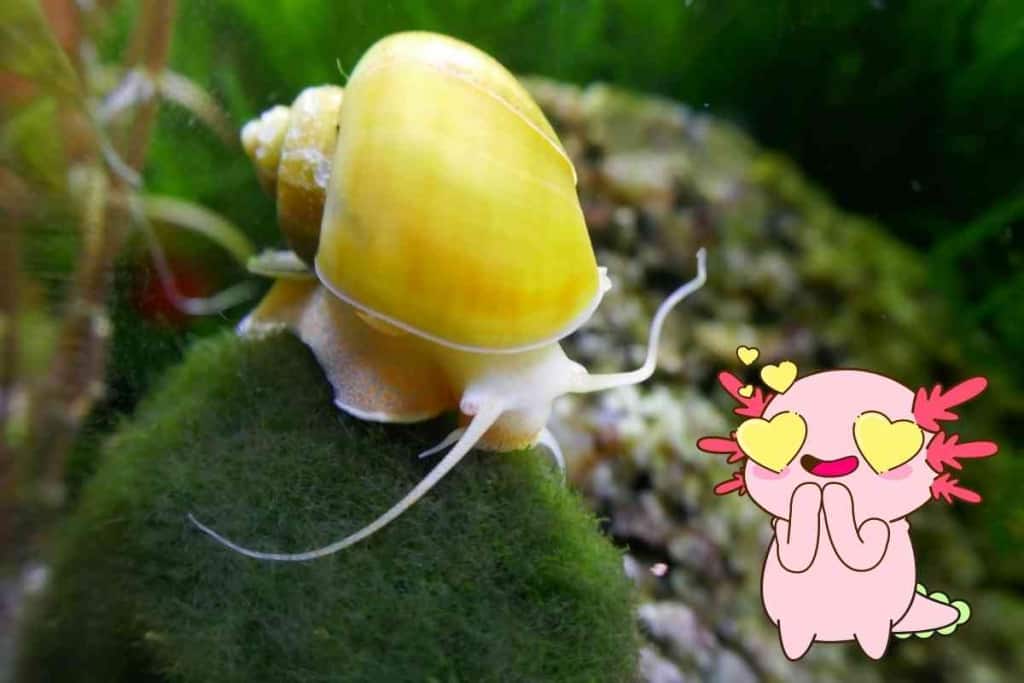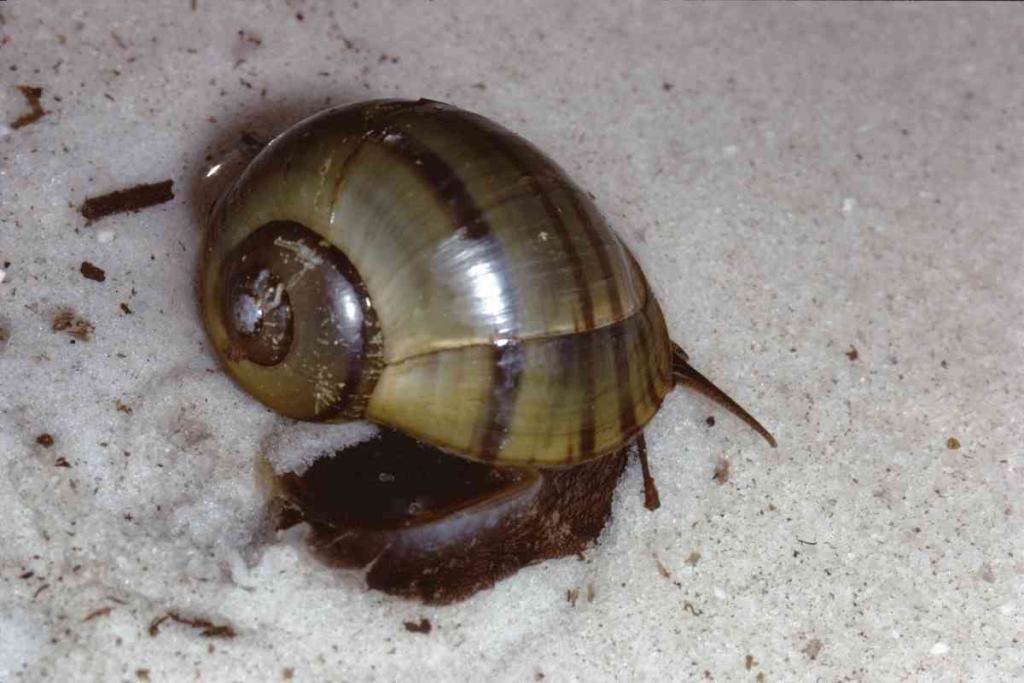Are Snails Safe For Axolotl To Eat?
In the diverse menu of axolotl delicacies, where do snails stand? This guide delves into the potential benefits and risks of feeding snails to axolotls. If you’re contemplating adding this mollusk to your axolotl’s diet, our insights will shed light on the best approach. Keep reading!
Can axolotl eat snails?
Axolotls love eating snails, but what matters is the kind of snails fed to them. Snails with hard and sharp shells aren’t recommended for axolotls. However, it is perfectly alright for axolotls to eat soft-shelled snails.
We’ve owned axolotls for quite a while now, and we’re always careful of what we allow our axolotls to eat. With that said, here, we’re going to use our experience to tell you more about these magnificent creatures and what kind of snails they can eat.

Which Snails Are Safe for Axolotls to Eat?
Axolotls can consume snails, but there are considerations. While snails provide calcium and other nutrients, they also carry potential risks like parasites or toxic substances if exposed to harmful chemicals.
Additionally, larger snails might pose a choking hazard. If offering snails, ensure they’re small, clean, and sourced from safe environments.
Apple Snails
When considering which type of snail to feed to an axolotl, apple snails are a safe choice. Unlike other types of snails, apple snails have a softer shell that is easier for the axolotl to bite and digest.
They also tend to be larger, making them a more substantial meal for the predator. However, apple snails can reproduce rapidly, so monitoring their population and controlling their numbers in the tank or pond is important.
In addition, apple snails may consume plant life and should not be kept with delicate or slow-growing plants.
Overall, apple snails make a good option for axolotl owners looking to provide variety in their pet’s diet. Just remember to keep an eye on their population and consider any impact they could have on tank flora.
Ramshorn Snails
When selecting snails for axolotls, Ramshorn snails are often a popular choice. This is because they have a softer shell than other varieties, making it easier for the axolotl to consume them without causing harm to their sensitive jaws.
Ramshorn snails also reproduce slower, making it easier for owners to control the population in their tanks.
However, it’s important to note that Ramshorn snails have some predatory tendencies and should not be kept with small fish or shrimp.
It’s also crucial to properly clean and quarantine any new Ramshorn snails before introducing them into the tank, as they may carry parasites or diseases that can harm your axolotl.
Overall, Ramshorn snails can make a safe and advantageous addition to an axolotl’s tank if properly cared for.
Bladder Snails
Unlike some other types of snails, Bladder snails have a softer shell that is less likely to harm an axolotl’s delicate mouthparts.
In addition, Bladder snails are smaller in size and usually do not reproduce as quickly, making it easier to maintain the appropriate snail population in the tank.
These snails also provide a useful source of food for axolotls, as they primarily consume algae and decaying plant matter.
However, it is important to note that all wild-caught snails should be quarantined before being introduced into the tank, as they could potentially bring in parasites or diseases. Bladder snails can make a safe and beneficial addition to an axolotl habitat.
Which Snails Aren’t Suitable for Axolotls?

Malaysian Trumpet Snail
The Malaysian Trumpet Snail, or MTS for short, may be small and seemingly harmless, but they pose a significant threat to axolotls.
These snails have sharp and hard shells, making them difficult to digest for the delicate axolotl gut.
Ingesting these snails can lead to indigestion and even clogged guts, causing impaction and potentially leading to serious health problems.
MTS reproduce quickly and can easily take over a tank if not controlled. Thus, it’s important to ensure they are not present in the axolotl’s habitat and remove any found before they cause harm.
Overall, the Malaysian Trumpet Snail should be avoided at all costs for the sake of axolotl health and safety.
Rabbit Snails
As exotic pet owners, it is important to research the potential dangers lurking in our tank inhabitants. For axolotls, one of the worst offenders is the Rabbit Snail.
This species is easily recognized by its hard and sharp shell and has been known to cause indigestion and even gastric impaction in axolotls if ingested.
The sharp edges of the shell can cut through the axolotl’s digestive tract, causing internal damage.
The indigestible material can also become lodged in the gut, leading to a potentially fatal blockage.
While Rabbit Snails may seem harmless, they should be avoided at all costs for axolotl tanks to prevent these serious health issues.
Why Must You Keep Snails in an Axolotl’s Tank?
They Eat Away the Excess Algae
When it comes to owning an axolotl, many aquarists struggle with controlling the algae in their tanks.
Algae can quickly take over a tank and harm the water quality and aesthetics.
Snails are a helpful addition to any axolotl tank as they eat away at excess algae. They consume algae on the tank walls and plants, keeping them clean and helping to regulate the amount of algae in the tank.
They also eat excess fish food and debris, making them valuable cleanup crew members in maintaining water quality.
Additionally, some snails work to aerate and mix up the substrate, promoting a healthier environment for the axolotl’s roots.
So when setting up an axolotl tank, consider adding some algae-eating snails for cleaner and healthier water conditions.
They Keep the Substrate Clean
The substrate in an axolotl tank is a layer of material on the bottom, typically gravel or sand, that provides a natural aesthetic and allows for burrowing and digging.
However, if left unchecked, the substrate can quickly become cluttered with uneaten food and waste. This can lead to contaminated water and unhealthy living conditions for your axolotl.
One solution to this problem is to introduce snails into the tank. Snails will naturally consume any leftover food and waste, keeping the substrate clean.
This not only helps to maintain water quality but also enhances the appearance of the tank by reducing excess debris on the bottom.
So next time you’re looking for a helpful addition to your axolotl’s tank, consider adding some snails to keep the substrate clean.
Why Your Axolotls Should Eat Snails
While they may not be a common food choice for humans, snails can provide important nutrients for axolotls.
One snail can contain up to 6 grams of fat, as well as 27 calories and 5 grams of protein. Furthermore, snails are low in carbohydrates, making them a good option for axolotls who require a balanced diet.
In addition to providing essential fat and protein, snails also contain calcium and phosphorus, helping to keep bones and teeth strong.
Snails should be included as part of a varied diet for axolotls, along with other appropriate foods such as bloodworms and commercial pellets.
So next time you’re out tending to your axolotl’s tank, consider adding some snails into the mix for a nutritional boost.
Key Takeaways
- First, ensure the snail is not toxic or harmful to your axolotl. Certain species of snails may contain toxins that can be harmful to your pet.
- Secondly, thoroughly clean and de-gut the snails before feeding them to your axolotls. This is done to remove any dirt or parasites.
- Next, limit feeding snails to only 10% of your axolotl’s diet to prevent overfeeding and potential nutritional imbalances.
- Fourth, use caution when feeding wild-caught snails, as they may have ingested pesticides or other pollutants that could harm your axolotl.
- Lastly, keep an eye on your axolotl’s overall health and behavior after feeding snails, as they may not agree with their stomachs.
